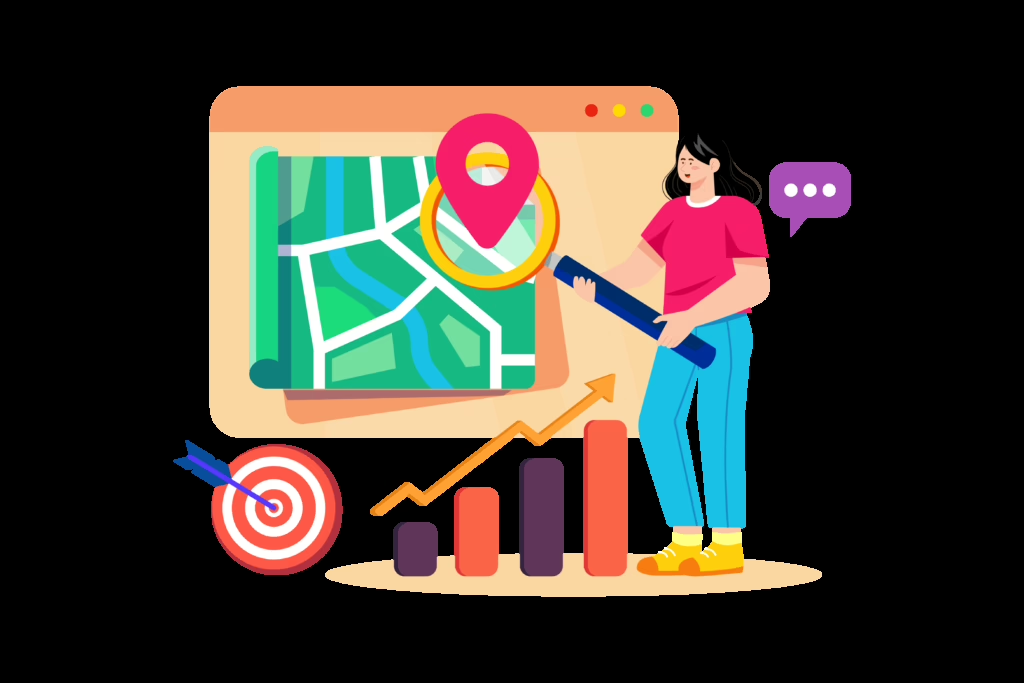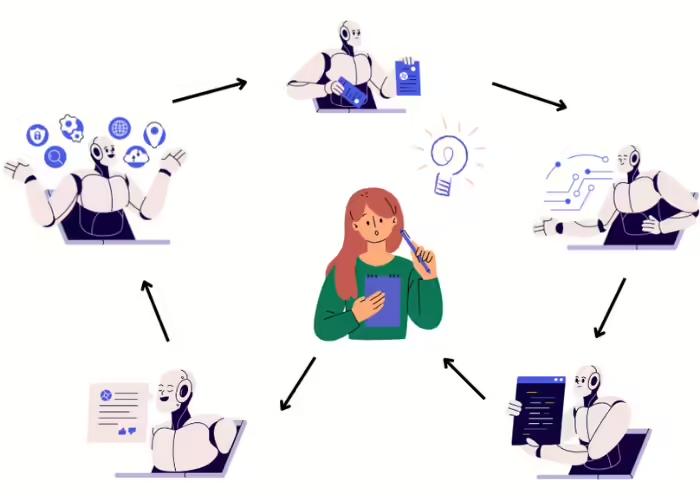Our Blog
We share our knowledge
Hyperlocal Marketing in Canada: Targeting and Engaging Your Community
Let’s face it—blanket marketing campaigns just don’t cut it anymore. Today’s consumers expect content that’s not only relevant but rooted in their everyday surroundings. That’s where hyperlocal marketing steps in. For Canadian businesses, this strategy isn’t just smart—it’s essential. Whether you’re a family-run bakery in Halifax or a clothing boutique in Vancouver’s Kitsilano, connecting with […]
In the ever-evolving world of digital marketing, Artificial Intelligence (AI) and Machine Learning (ML) have shifted from tech buzzwords to real business game-changers. The application of AI and Machine Learning, particularly in Canadian digital marketing, is noteworthy. Forward-thinking brands across Canada are leveraging these technologies to streamline operations, deliver ultra-personalized experiences, and uncover insights no […]

Brand loyalty today isn’t just about repeat business—it’s about emotional connection. People aren’t just buying your product; they’re buying into your brand. And more often than not, those connections are being formed, nurtured, and solidified online. If you’re not prioritizing building brand loyalty through digital channels, you could be missing one of your biggest growth opportunities.
With the right digital strategies, you can turn a first-time buyer into a lifelong fan. It all comes down to how well you engage, personalize, and show up—consistently—across the platforms your customers already live on.
What Brand Loyalty Really Means Today
Brand loyalty isn’t just about someone coming back for a second purchase. It’s when customers stick with your brand—even if there’s a cheaper or newer option on the market. Why? Because they feel something for your brand. That kind of loyalty isn’t rational—it’s emotional.
In our hyper-connected world, your ability to spark and maintain those feelings lives in the digital space. A smooth app experience, a personalized email, or even a thoughtful reply on social media—these touchpoints build trust over time.
Why Digital Channels Are the Game-Changer
Smartphones, smartwatches, tablets—this is where modern consumers make decisions. From discovery to checkout to post-purchase, digital channels are the glue holding the customer journey together.
Here’s why they matter:
- You can reach customers instantly
- Personalization becomes scalable
- Feedback is real-time
- Responses can be lightning-fast
In short: digital tools make loyalty-building more effective, more efficient, and more human.
What Drives Brand Loyalty Emotionally?
At its core, loyalty is built on two things: trust and satisfaction. But there’s another layer—emotion. People are more likely to stick around when they feel seen, heard, and appreciated.
Digital tools help tap into this emotional layer through:
- Relatable storytelling
- Responsive customer support
- Interactive, human-centered content
How to Build Brand Loyalty Through Digital Channels (Without Overwhelming Your Audience)
Building loyalty digitally isn’t about spamming inboxes or posting nonstop. It’s about quality interactions and smart engagement.
Here’s what actually works:
- Share content that adds value, not just visibility
- Deliver consistent, exceptional digital experiences
- Leverage data to create meaningful personalization
Every digital touchpoint should reinforce your brand’s promise.
Social Media: The Modern Loyalty Playground
Think of social platforms like Instagram, TikTok, Facebook, and X (formerly Twitter) as today’s digital hangouts. If you want to build brand loyalty, show up authentically where your audience already is.
Try this:
- Give sneak peeks behind the scenes
- Run interactive polls and Q&As
- Celebrate your biggest fans publicly
- Share user-generated content to build community
These small actions add up—and help make your brand feel more personal.
Email Marketing Isn’t Dead. It’s Your Loyalty Secret Weapon
Despite being one of the oldest digital channels, email still delivers one of the highest ROIs—especially for loyalty.
Here’s how to make it feel personal, not pushy:
- Segment your audience based on real behavior
- Use dynamic subject lines and personalized content
- Set up automated flows for key touchpoints (welcome emails, abandoned cart reminders, etc.)
- Give early access, exclusive deals, or birthday bonuses
The goal? Make every email feel like it’s written just for them.
Storytelling > Selling: Content Marketing That Builds Loyalty
People don’t fall in love with sales pitches—they fall in love with stories. When your content educates, entertains, or inspires, it strengthens the emotional bond with your audience.
Think:
- Blog posts that answer real questions
- Behind-the-scenes videos
- Webinars that provide actionable insight
- Podcasts that build trust over time
When people trust your content, they’re more likely to trust your brand.
Influencers Can Be Loyalty Catalysts
The right influencers especially micro-influencers—have the power to turn passive followers into engaged fans. They bring credibility, authenticity, and niche reach that’s hard to match through brand messaging alone.
Look for partners who:
- Genuinely align with your brand values
- Speak directly to your target communities
- Prioritize real engagement over vanity metrics
Bring Loyalty Programs Online (And Make Them Fun)
Modern loyalty programs live where your customers do—online. They should be easy to use, mobile-friendly, and genuinely rewarding.
Popular features:
- Point-based systems
- Tiered VIP programs
- Referral bonuses
- Surprise perks
Gamify them to keep customers engaged and coming back.
Personalization + Automation = Loyalty Magic
Personalization used to mean adding a name to an email. Now, it means recommending the right product at the right time through the right channel.
Tools to consider:
- AI-powered product recommendations
- Dynamic web content
- Behavioral-triggered email sequences
When customers feel understood, loyalty becomes natural.
Looking Ahead: The Future of Digital Brand Loyalty
The next wave of loyalty will be powered by:
- Voice assistants and smart tech
- Blockchain for loyalty points
- Augmented and virtual experiences
- AI that delivers hyper-personalization
Brands that stay agile and embrace innovation will be the ones customers stick with.
Final Thoughts
Building brand loyalty through digital channels isn’t a one-off campaign—it’s an ongoing commitment. It’s about crafting consistent, emotionally resonant experiences that make your audience feel like they matter.
Think of your digital touchpoints as your brand’s most valuable frontline. Treat them accordingly. Because in this digital age, loyalty isn’t given—it’s earned.

Let’s face it—blanket marketing campaigns just don’t cut it anymore. Today’s consumers expect content that’s not only relevant but rooted in their everyday surroundings. That’s where hyperlocal marketing steps in.
For Canadian businesses, this strategy isn’t just smart—it’s essential. Whether you’re a family-run bakery in Halifax or a clothing boutique in Vancouver’s Kitsilano, connecting with your immediate community builds stronger trust, more foot traffic, and brand loyalty that’s hard to beat.
Understanding Hyperlocal Marketing
Hyperlocal marketing targets potential customers in a tight, geographically defined area, think a postal code, a few city blocks, or even a single street. It’s all about being right here, right now with the people who matter most.
Why It’s Crucial in Canada
From the French-speaking charm of Montreal to the multicultural neighborhoods of Toronto, Canada is anything but one-size-fits-all. Hyperlocal campaigns help businesses speak directly to their communities—in the right language, tone, and context.
Benefits of Hyperlocal Marketing for Canadian Businesses
- More Community Engagement
- When your message feels personal and relevant, people notice. Localized promotions and content resonate more deeply, increasing likes, shares, and real-life conversations.
- Better Conversion Rates
- A geo-targeted ad saying “Lunch deals on Main Street today” beats a generic promotion every time. Relevance drives clicks—and real foot traffic.
- Stronger Customer Trust
- When you consistently support local causes or highlight community stories, you’re not just another business—you’re a local partner. That kind of authenticity builds loyalty.
Geo-Targeted Advertising in Canada
Using GPS, Wi-Fi, IP addresses, or mobile data, businesses can deliver ads to people based on their real-time or past locations. Whether you’re promoting a deal near Toronto’s Union Station or highlighting an event in Winnipeg’s Exchange District, geo-targeting keeps your message relevant.
Platforms That Work in Canada
- Google Ads Local Campaigns – Ideal for local searches like “coffee shop near me.”
- Facebook & Instagram Local Awareness Ads – Show posts to people within a set radius.
- Yelp & Waze Ads – Reach drivers or locals searching nearby.
- Snapchat Geofilters – Great for events or location-based promotions, especially among Gen Z.
Hyperlocal Social Media Strategies
Join the (Neighbourhood) Conversation
- Facebook Groups: Join local buy-and-sell, parenting, or foodie groups.
- Nextdoor: Especially powerful in residential communities.
- Instagram & TikTok Hashtags: Try #TorontoEats or #YEGfashion to surface in local searches.
- Sponsor a booth at the local farmers’ market, share behind-the-scenes stories at the Vancouver Pride Parade, or do a giveaway tied to a Moose Jaw hockey night
Mobile Marketing & Push Notifications
- Location-Based Mobile Apps
- If you have an app—or can partner with one—use geo-permissions to send real-time alerts like “Your morning coffee’s waiting just around the corner at Main & Broadway.”
- Beacon Technology
- Place small Bluetooth beacons near your storefront to trigger push notifications when someone walks by—perfect for flash sales or exclusive deals.
Conclusion: The Local Advantage
Hyperlocal marketing is more than a trend, it’s how Canadian businesses are staying relevant, real, and rooted in their communities. From geo-targeted ads to local events and mobile alerts, it’s all about meeting your customers where they are—literally.

In the ever-evolving world of digital marketing, Artificial Intelligence (AI) and Machine Learning (ML) have shifted from tech buzzwords to real business game-changers. The application of AI and Machine Learning, particularly in Canadian digital marketing, is noteworthy. Forward-thinking brands across Canada are leveraging these technologies to streamline operations, deliver ultra-personalized experiences, and uncover insights no spreadsheet ever could.
Personalized Marketing at Scale
AI has turned personalization into a superpower for Canadian brands. Whether it’s Shopify suggesting the perfect product or Indigo recommending your next favourite read, machine learning algorithms are creating one-to-one experiences on a massive scale. This transformation in Canadian digital marketing is driven by AI.
Email marketing? That’s getting smarter, too. Tools like Klaviyo and Mailchimp help marketers send the right message at the right time—without lifting a finger. This kind of automation doesn’t just save time—it boosts open rates, clicks, and conversions.
The Power of AI Analytics
Imagine knowing what your customers want before they do. That’s predictive analytics in action. Harnessing AI and machine learning insights has become a cornerstone of Canadian digital marketing. Companies from banking to retail use historical data to predict churn, optimize inventory, and even suggest new products.
Platforms like Google Analytics 4 and Tableau are now infused with AI, delivering real-time insights. These platforms help marketers pivot quickly and make data-backed decisions faster than ever.
Creating Content That Ranks with AI
Content creation is no longer just human-powered. Canadian digital marketing embraces AI, with marketers turning to tools like Jasper and Grammarly. These tools speed up writing, fine-tune tone, and nail SEO structure.
Meanwhile, SEO is going through its own AI-fueled glow-up. Tools like Surfer SEO and SEMrush dig into user intent, keyword competition, and UX metrics. These tools give marketers an edge in Google’s ever-shifting algorithm game.
AI in Ads and Visual Storytelling
Gone are the days of “spray and pray” advertising. With AI, Canadian marketers now use programmatic platforms that auto-optimize based on engagement and user behaviour. This demonstrates AI’s critical role in Canadian digital marketing strategies.
Visual content is getting an AI upgrade too. In fashion, real estate, and lifestyle sectors, brands use visual recognition tech to analyze trends. This technology helps craft content that pops on visual-first platforms like Instagram and Pinterest.
The Rise of Conversational AI and Voice Search in Canada
Chatbots have gone mainstream, especially in Canadian digital marketing for banking and retail. These AI assistants handle customer questions, book appointments, and guide users without a hitch. They free up human teams for more complex tasks.
And with the rise of voice assistants like Google Nest and Alexa, optimizing for voice search is a must. That means focusing on natural, conversational phrases—especially local ones like “best brunch spot in Vancouver.”
Balancing Personalization with Privacy: The Canadian Challenge
With great data comes great responsibility. Canada’s PIPEDA laws mean businesses must be transparent, secure, and ethical in their AI use.
Forward-thinking marketers are responding by using anonymized data and adopting privacy-first frameworks, earning customer trust while still delivering tailored experiences.
Final Thoughts: AI Is No Longer Optional in Canadian Marketing
From smarter segmentation and automation to predictive insights and voice optimization, the role of AI and machine learning in Canadian digital marketing is expanding fast. It redefines how brands engage with unique audiences.
Businesses that embrace these tools now will be better positioned to thrive. They will offer richer customer experiences, achieve stronger ROI, and stay ahead of the curve in a fast-changing digital world.

As the holidays approach, businesses worldwide recognize a unique opportunity to connect with consumers. The holiday season brings an influx of shoppers, eager for the best deals, gift ideas, and memorable experiences. While some may see the holiday rush as a challenge, savvy businesses know it’s the perfect moment to capitalize on heightened consumer spending and engagement. This article explores the comprehensive benefits of marketing during the holidays, offering valuable insights into how holiday campaigns can drive results across industries.
Increased Consumer Spending Drives Revenue
The holiday season brings a surge in consumer spending, and businesses can capitalize on this with well-planned holiday campaigns. Seasonal promotions such as discounts, bundle deals, and exclusive offers cater to shoppers looking for value, which can increase average cart values and encourage multiple-item purchases. This phenomenon isn’t restricted to retail; service industries like hospitality, travel, and professional services also see heightened demand, as people look to create memorable holiday experiences. Marketing holiday-themed packages or services can help capture a share of this spending.
The uptick in spending isn’t limited to retail alone. Service industries, hospitality, travel, and even professional services experience heightened demand. Marketing holiday packages, gift certificates, or seasonal service offerings helps these businesses capture a share of the holiday budget as consumers seek unique gifts and experiences.
Boosting Brand Visibility and Recall
With the abundance of holiday-related content circulating online and offline, brands have an opportunity to increase visibility and make lasting impressions. When consumers repeatedly encounter a brand’s holiday content, it strengthens recall and establishes a connection that can translate into post-holiday loyalty. Tailoring messages to the holiday spirit with festive visuals and themes can help brands stand out, creating a memorable identity.
Effective holiday marketing campaigns can establish emotional ties with audiences by aligning with their sentiments during this time. Storytelling that reflects themes of giving, joy, and nostalgia engages customers and fosters brand loyalty. By sharing stories that highlight customer experiences, community involvement, or charitable efforts, businesses can build relationships that last well beyond the season.
Building Long-Term Loyalty
Strategic holiday marketing can lay the groundwork for long-term customer relationships. By creating an emotional connection with customers during the holidays, brands position themselves as top-of-mind choices when future needs arise. Engaging holiday marketing campaigns can inspire brand loyalty that extends well beyond the season.
Enhanced Engagement and Consumer Interaction
Holiday marketing often leads to higher customer engagement as shoppers are more likely to interact with seasonal content, especially if it’s designed to be interactive. Holiday-themed contests, giveaways, and personalized messages are effective methods to capture interest and build rapport. For example, businesses can offer chances to win holiday-themed prizes or exclusive deals, encouraging social sharing and expanding their reach.
Mobile and social media also play a key role in engagement during this period. With the surge in mobile shopping, ensuring that websites and ads are mobile-friendly enhances user experience and conversion rates. Targeted social media campaigns and app-exclusive holiday offers further attract customers who prefer to shop on-the-go.
Contests and Giveaways
Holiday-themed contests and giveaways are highly effective at generating interest and engagement. By offering a chance to win a holiday prize or a special gift, businesses can encourage social shares, increase followers, and improve brand sentiment, all while amplifying the reach of their holiday campaigns.
Expanding Market Reach
Holiday marketing is an opportunity to reach new customers beyond the brand’s typical audience. Gift guides, festive blog posts, and themed videos attract diverse groups looking for gift ideas and holiday inspiration. Influencer partnerships are also highly effective, as influencers often showcase products in ways that resonate with their engaged audiences. By aligning with these influencers, brands can expand their reach significantly, gaining visibility with potential new customers.
Gathering Data for Future Campaigns
The holiday season provides a wealth of customer data that can be invaluable for future marketing efforts. As new customers interact with the brand, businesses can gain insights into customer preferences, behavior, and purchase patterns, building profiles that inform future campaigns. Analytics allow brands to track which promotions, products, or messages resonate most, optimizing future efforts based on solid data.
Long-Term Impact of Holiday Marketing
While the holiday season is temporary, effective marketing during this time can have lasting benefits. By creating memorable customer experiences, building trust, and establishing a positive brand perception, businesses set themselves up for success well into the new year. A strong holiday marketing campaign can position a brand as generous, reliable, and customer-focused, traits that leave a lasting impression on consumers and lay the foundation for year-round growth.
Conclusion
Holiday marketing offers a powerful way to elevate brand awareness, boost sales, and build strong customer relationships. By tapping into holiday sentiments, optimizing mobile and social platforms, and creating meaningful campaigns, businesses across industries can make a memorable impact that benefits them far beyond the holiday season. Each festive interaction reinforces a brand’s position, enhancing consumer trust and creating a foundation for lasting success.

In today’s fast-moving digital landscape, time is perhaps the most valuable resource. Whether you’re a business owner, a marketer, or a content creator, finding ways to boost efficiency is essential. That’s where artificial intelligence (AI) comes into play. Using AI to automate content creation—whether for blogs, newsletters, or email campaigns—comes with a wide range of perks, from boosting productivity to ensuring your content hits the mark. It’s not just the latest trend; it’s a strategic move that allows creators to focus on what truly matters—the human element—while letting tech handle the repetitive stuff. This article explores just how AI is transforming the way we create and share content.
AI and Its Role in Modern Marketing
Artificial intelligence has already shaken up plenty of industries, and marketing is no exception. The way AI can mimic human intelligence means it can take on tasks like writing, analyzing data, and predicting trends—all key in the world of marketing.
Look at social media, for example. AI is the driving force behind what content you see, moderating conversations, and even suggesting new accounts to follow. The same tech can take a lot of the legwork out of creating content like blogs, newsletters, and emails. It doesn’t just save you time; AI tools provide useful insights and recommendations to make your marketing efforts more effective overall.
Benefits of Utilizing AI for Automating Blogs
Blogs are vital for driving traffic, building authority, and connecting with your audience. But cranking out high-quality, SEO-friendly content on a consistent basis? That can be a grind. Here’s where AI can step in and lighten the load.
1. Automating Topic Research and Keyword Selection
- AI can analyze vast amounts of data to identify trending topics and relevant keywords. It allows content creators to pinpoint exactly what their audience is interested in at any given time. For example, AI tools can assess data from social media, search engines, and other online platforms to predict which topics will resonate most. This eliminates the guesswork from topic selection and ensures blogs are always relevant and timely.
2. Enhanced SEO and Content Optimization
- SEO is crucial for any blog, and AI-powered tools can optimize content in ways humans might overlook. From keyword density to meta descriptions, AI algorithms can suggest changes that boost the blog’s search engine ranking. Additionally, AI can optimize the readability of content, ensuring it appeals to a broader audience and aligns with search engine requirements.
3. Creating First Drafts and Enhancing Writing
- Generative AI tools can produce first drafts of blog posts, saving writers hours of time. These tools can generate content based on prompts, delivering structured, coherent articles that writers can then refine with their own unique voice and perspective. This method speeds up the writing process while maintaining the personal touch necessary for engaging readers.
4. Analyzing Performance and Suggesting Improvements
- AI doesn’t stop at content creation. It also plays a role in performance analysis. By tracking engagement metrics such as views, shares, and time spent on a page, AI tools can suggest content improvements. For instance, they can identify underperforming posts and recommend updates to headlines or content structure to drive better results.
AI in Newsletter Automation
Newsletters are an incredible way to maintain a strong connection with your audience. But crafting personalized, engaging content for each subscriber? That’s a lot of work. Luckily, AI can make the whole process smoother.
1. Personalization at Scale
- AI excels in personalizing content for individual readers. It can analyze subscriber data, such as past interactions or preferences, and tailor newsletter content accordingly. This ensures that every subscriber receives content that is relevant to them, which significantly increases open rates and engagement.
2. Automated Content Curation
- Curating content for newsletters can take hours. However you can automatically pull in content based on specific topics, keywords, or user interests. This automation reduces the workload on content teams and ensures newsletters are always filled with relevant, high-quality material.
3. A/B Testing for Optimized Content
- AI can assist in A/B testing by automatically running multiple versions of a newsletter and analyzing which version performs best. It can recommend changes to subject lines, calls-to-action (CTAs), and even layout designs based on real-time feedback, ensuring your newsletters are always optimized for performance.
4. Scheduling and Automation
- The timing of a newsletter can be critical to its success. Analyze subscriber behavior and suggest the optimal times to send emails. Whether your audience engages more during the early morning or late at night, AI can handle scheduling to maximize open rates and engagement.
Enhancing Email Campaigns
Email marketing remains one of the most effective tools in the marketing toolbox. But managing all those campaigns manually can feel overwhelming. AI can take on the heavy lifting, leaving you free to focus on strategy.
1. Dynamic Content Creation
- AI can generate personalized email content based on user data. For example, AI tools can craft customized subject lines, body text, and CTAs tailored to individual recipient preferences. This ensures that emails speak directly to the recipient, increasing the likelihood of engagement and conversions.
2. Predictive Analytics for Targeting
- Predictive analytics, powered by AI, can predict which users are most likely to take action after receiving an email. By analyzing past behaviors, such as previous purchases or interaction with content, AI can help segment audiences and send targeted emails to those most likely to convert.
3. Optimizing Delivery Time
- Much like with newsletters, AI can determine the best time to send emails for maximum engagement. This is especially important when dealing with large, segmented audiences. Instead of sending emails in bulk, AI can ensure that each recipient gets the email at a time when they’re most likely to engage with it.
4. Automating Follow-ups and Drip Campaigns
- AI can automate follow-up emails and drip campaigns based on recipient behavior. If someone opens an email but doesn’t click the CTA, AI can trigger a follow-up email with new messaging designed to drive action. Similarly, for leads who engage with multiple emails, AI can manage the flow of a drip campaign, gradually nurturing them toward conversion.
The Impact of AI on Productivity and Costs
AI’s ability to automate blogs, newsletters, and emails doesn’t just save you time—it can also help reduce costs. By taking over tasks that used to require hours of manual effort, AI allows you to scale up content creation without having to hire more staff. And because AI continuously learns and improves, your content quality gets better the more you use it.
Conclusion: Why You Should Embrace AI for Content Automation
Leveraging AI for automating blogs, newsletters, and email campaigns is not just a tech trend—it’s a smart, future-forward strategy. By embracing AI, you can streamline time-consuming tasks, gain actionable insights, and optimize your content for better results—all while saving valuable time and resources. Whether you’re running a small business or leading a large marketing team, AI gives you the tools to scale your efforts, personalize your communication, and stay competitive in today’s fast-paced digital world.

In today’s rapidly shifting business environment, maintaining strong client interaction, ensuring retention, and driving lead acquisition have all become essential priorities. AI-powered phone dialers are proving to be revolutionary tools in this regard, offering businesses unmatched efficiency and personalized outreach. These intelligent systems allow companies to scale their communication efforts, boost retention rates, and streamline the process of lead generation, all while delivering a tailored customer experience.
With competition intensifying across industries, AI phone dialers are invaluable for automating repetitive tasks, allowing sales and customer service teams to focus on higher-value activities. This article takes a closer look at how AI dialers are reshaping business operations, improving sales efficiency, and enhancing client interaction, retention, and lead acquisition.
The Power of AI Phone Dialers in Sales Efficiency
Sales efficiency is essential for maintaining a competitive edge, and AI phone dialers are dramatically improving how sales teams operate. Sales reps no longer have to manually dial numbers or leave voicemail messages. Today’s AI-powered dialers handle those routine tasks, freeing up time for sales professionals to focus on relationship-building and closing deals.
By automating the dialing process and incorporating personalized communication, AI dialers help sales teams focus on tasks like conducting in-depth prospect research. This additional time allows them to gain better insights into customer needs and pain points, ultimately equipping them with the knowledge needed to offer more targeted solutions.
AI dialers also prioritize leads using data analysis, sorting them based on demographics, purchase behavior, and engagement trends. This ensures that sales efforts are directed toward the most promising prospects, which leads to higher conversion rates and increased revenue. Additionally, businesses can use real-time analytics to monitor performance and make informed, data-driven decisions to optimize sales strategies.
AI Phone Dialers and Lead Prioritization
One of the biggest advantages of AI phone dialers is their ability to prioritize leads intelligently. These systems analyze customer data to identify which prospects are most likely to convert, helping sales teams focus on the right opportunities. This data-driven approach takes the guesswork out of lead qualification and ensures that resources are used more efficiently.
For instance, AI dialers can evaluate a lead’s online behavior, previous interactions, and social media activity to gauge their likelihood of conversion. This automated process speeds up the sales cycle and improves the quality of leads targeted, resulting in better conversion rates.
Moreover, AI dialers automate follow-ups and reminders, ensuring that no lead slips through the cracks. By scheduling calls at optimal times and customizing conversations based on real-time data, AI systems help businesses maintain steady engagement with leads throughout the sales funnel, without overwhelming their teams.
Improving Customer Retention with AI Dialers
In addition to generating new leads, AI phone dialers play a pivotal role in enhancing customer retention. Personalized communication is key to building long-term relationships, and AI systems are adept at delivering tailored interactions at scale. Whether it’s a post-purchase follow-up, a renewal reminder, or a special offer based on previous purchases, AI dialers ensure that customers feel valued throughout their journey with the brand.
By analyzing customer data in real time, businesses can send personalized messages that boost satisfaction and foster loyalty. For example, an AI dialer might contact a customer shortly after a purchase to confirm their satisfaction and suggest complementary products. This proactive outreach enhances the customer experience and encourages repeat business.
AI dialers also provide around-the-clock availability, allowing businesses to engage with customers across different time zones. This flexibility improves the customer experience by ensuring that inquiries and issues are addressed promptly, leading to higher retention rates and more consistent engagement.
The Role of AI Phone Dialers in Customer Outreach
Effective customer outreach is crucial for building strong relationships and staying competitive in today’s fast-paced market. AI phone dialers have transformed how businesses engage customers by offering personalized, 24/7 communication tailored to each customer’s needs.
AI-powered systems collect and analyze customer data in real time, enabling businesses to craft offers and messages that resonate on an individual level. This targeted approach not only boosts customer satisfaction but also increases conversion rates. Moreover, AI dialers can handle a high volume of calls simultaneously, making them highly cost-effective for businesses looking to scale their outreach without significantly increasing overhead.
A key advantage of AI dialers is the ability to provide real-time insights into customer behavior and preferences. By analyzing call data, businesses can gain valuable information on what customers want, their pain points, and how they respond to different offers. This information can be used to refine marketing strategies and improve overall customer satisfaction.
Challenges and Solutions in Implementing AI Dialers
While AI phone dialers offer undeniable benefits, businesses must also address a few challenges when integrating them into their workflows.
Privacy Concerns
- Data privacy is a common concern when it comes to AI systems. Customers may be hesitant about how their personal information is being used. To overcome this, businesses must be transparent about their data use and comply with data protection regulations like GDPR. By obtaining explicit consent and safeguarding data, businesses can build trust with customers.
Maintaining the Human Touch
- Though AI dialers excel at handling routine tasks, human interaction remains essential in certain situations. Striking a balance between automation and human engagement is key. While AI can manage initial outreach and follow-ups, human agents should step in for more complex conversations that require relationship-building. This hybrid approach ensures that businesses maintain a personal touch while benefiting from AI’s efficiency.
Real-World Applications of AI Phone Dialers
Healthcare
- In the healthcare industry, AI dialers streamline tasks like appointment scheduling, reminders, and follow-ups. This frees medical staff to focus on patient care while ensuring that appointments aren’t missed.
E-commerce
- E-commerce businesses benefit from AI dialers by providing follow-ups on recent purchases and offering personalized product recommendations. This helps drive repeat purchases and strengthens customer loyalty.
Real Estate
- Real estate agents use AI dialers to qualify leads more efficiently, allowing them to focus on serious buyers. AI systems can also respond to property inquiries, keeping potential buyers engaged.
The Future of AI Dialers in Business
Looking ahead, AI dialers will continue to evolve and become even more integrated into business operations. Advancements in natural language processing will allow AI systems to handle increasingly complex conversations.
Predictive Analytics
- AI dialers will soon integrate more sophisticated predictive analytics, allowing businesses to anticipate customer needs and offer solutions before issues arise, enhancing customer satisfaction and boosting conversion rates.
Continued Innovation
- As AI technology advances, businesses can expect even more powerful tools for automating customer engagement, from real-time sentiment analysis to better voice recognition.
Conclusion
AI phone dialers have become indispensable tools for businesses, enabling improved client interaction, higher retention rates, and more efficient lead acquisition. By automating routine tasks, prioritizing leads with data analysis, and offering personalized communication at scale, AI dialers are revolutionizing how businesses approach sales and customer outreach.
By embracing these AI-driven solutions and addressing challenges such as privacy concerns, businesses can better position themselves for long-term success in an increasingly competitive market.




